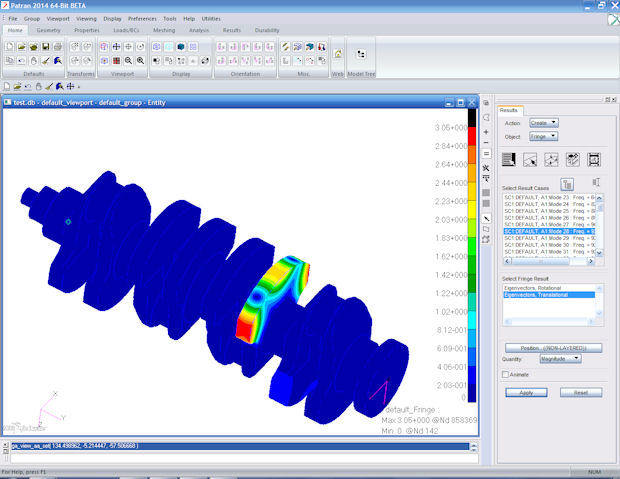Editor’s Pick: MSC Nastran and Patran 2014 Released

An MSC Nastran stress analysis of a crankshaft. MSC Nastran image courtesy of MSC Software Corp.
Latest News
December 17, 2014
 Dear Desktop Engineering Reader:
Dear Desktop Engineering Reader:
 MSC Software just released the 2014 version of its venerable MSC Nastran multidisciplinary structural analysis solution as well as the 2014 edition of its widely deployed Patran FEA (finite element analysis) modeling solution. Since Nastran resides on top of engineering’s Mount Olympus along with things like NI LabVIEW, MS Excel and Star Trek paraphernalia, this is big news. Here’s a quick look.
MSC Software just released the 2014 version of its venerable MSC Nastran multidisciplinary structural analysis solution as well as the 2014 edition of its widely deployed Patran FEA (finite element analysis) modeling solution. Since Nastran resides on top of engineering’s Mount Olympus along with things like NI LabVIEW, MS Excel and Star Trek paraphernalia, this is big news. Here’s a quick look.
As is its custom, MSC Software has introduced new features and enhanced others throughout the MSC Nastran toolset. Still, in general, you’ll find performance enhancements a common thread throughout this release. Take, for example, explicit nonlinear analyses. On multi-core configurations, the performance has improved by a factor of two. And the 2014 version of the Krylov solver, which reduces the number of matrix factorizations performed during frequency response analyses, sees improved performance with new DMP (distributed memory parallel) technology that enables it to run across multiple compute nodes. Frequency computations for non-symmetric systems are also three times faster in version 2014, according to MSC.
MSC Nastran’s embedded fatigue analysis capabilities received a lot of attention from the version 2014 development team. It now has extended support for seam and spot welds fatigue analyses. This support, MSC says, will make it easier for you to identify the critical welds in automobiles and similar structures subjected to repeated loads. Another enhancement, multi-axial assessments, helps you better determine the validity of standard stress-life or strain-life fatigue analyses. Other features include support for industry-standard remote parameter control (RPC) and 2-pass and 3-pass fatigue analyses. Overall fatigue analyses performance has been improved.
MSC Nastran’s external superelement (SE) linear analysis capability has been enhanced in version 2014 to give you the ability to rotate, move or mirror a primary external SE. In other words, you can now activate and deactivate rigid elements in subcases. MSC Nastran’s advanced nonlinear analysis contact capability has been improved in version 2014 for complex problems such as eigenvalue extraction on pre-stressed bodies that you encounter in wind turbine analyses. Version 2014 also supports nonlinear analysis with linear perturbations.
For explicit nonlinear analyses, MSC Nastran 2014 has a new, enhanced partitioner for block Euler meshes that should improve performance while increasing your productivity. What’s going on here is a Euler mesh must be partitioned and distributed to be parallelized. Previously, you had to exert a lot of elbow grease to do this. Version 2014’s new partitioner scheme will find the optimal partitions with minimal effort.
The 2014 version of the Patran pre-/post-processor supports all the new fatigue analysis capabilities and nonlinear analysis advances mentioned above. Patran’s CAD import/export features have been upgraded for recent CAD system releases and see a 25% performance increase, according to MSC. Visualizations are also reported to be much faster than previous editions.
You can learn more about the 2014 releases of MSC Nastran and Patran from today’s Pick of the Week write-up. Set aside an hour and watch the on-demand, registration-free overview you’ll find linked at the end of the main text. Download the PDF overview for an in-depth, technically dense summary of what’s new in MSC Nastran 2014. Good stuff.
Thanks, Pal. — Lockwood
Anthony J. Lockwood
Editor at Large, Desktop Engineering
Read today’s pick of the week write-up.
This is sponsored content. Click here to see how it works.
Subscribe to our FREE magazine, FREE email newsletters or both!
Latest News
About the Author
Anthony J. Lockwood is Digital Engineering’s founding editor. He is now retired. Contact him via [email protected].
Follow DE





